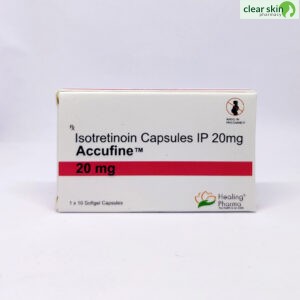Nadoxin Cream 10 gm
Most of the time, fluoroquinolone antibiotics like Nadoxin Cream 10 gm are used to treat skin infections and acne vulgaris that are caused by bacteria. An infection that starts in the body and is caused by bacteria is called a bacterial infection. It can spread quickly and can attack any part of the body.
Nadoxin Cream 10 gm is an antibacterial cream that you put on your skin. It helps treat and prevent bacterial skin infections. It works because it kills the bacteria that cause infections. It stops germs from fixing themselves and kills them, which stops the infection from spreading. The antibiotic in Nadoxin Cream 10 gm kills most Gram-negative bacteria, as well as many Gram-positive bacteria and some anaerobes (that lives without oxygen).
Use Nadoxin Cream 10 gm according to your doctor’s instructions for how much to use and how long to use it. In some cases, the area where the medicine was put on may react by burning, itching, or giving you rashes. Most of these side effects of Nadoxin Cream 10 gm don’t need medical care and will go away on their own. But if the bad effects don’t go away, you should talk to your doctor.
Tell your doctor if you are allergic to nadifloxacin or any of the other ingredients in Nadoxin Cream 10 gm. Nadoxin Cream 10 gm shouldn’t be used on skin that is broken, and it shouldn’t get in your eyes, nose, or mouth. If your doctor doesn’t tell you to, don’t cover the infected area with an airtight dressing like a bandage. This could increase the chance of side effects. If you are breastfeeding, make sure to clean the area well before feeding your baby, because Nadoxin Cream 10 gm might be harmful if it gets into the milk.
How to Use Nadoxin Cream 10 gm for Bacterial Infections

Medicinal Advantages
The antibiotic Nadifloxacin is in Nadoxin Cream 10 gm. This medicine treats and prevents bacterial skin infections caused by most Gram-negative bacteria, many Gram-positive bacteria, and some anaerobes bacteria, like Cutibacterium acnes and Staphylococcus epidermidis. It kills bacteria that cause diseases by stopping them from making their cell walls, which they need to stay alive. It also stops bacteria from fixing their own cells. It gets rid of all of the germs. The good thing about Nadoxin Cream 10 gm is that it works well in most deep tissues. Because of this, it is used to treat skin infections caused by bacteria.
How to Use Nadoxin Cream for Use Your doctor will tell you how much 10 gm to use and how long to use it.
Keep things in a cool, dry place out of direct sunlight.
Nadoxin Cream 10 gm Side Effects
As with any drug, Nadoxin Cream 10 gm can cause side effects, but not everyone has them. In some cases, the area where the medicine was put on may react by burning, itching, or giving you rashes. Most of these side effects of Nadoxin Cream 10 gm don’t need medical care and will go away on their own. But if the bad effects don’t go away, you should talk to your doctor.
Drug Recommendations
Do not use nadifloxacin if you are allergic to it or any other quinolone or fluoroquinolone antibiotic, such as delafloxacin, levofloxacin, moxifloxacin, or ciprofloxacin, or if you have had a severe reaction to it before. Also, people who are taking Nadifloxacin should stay out of the sun because it may make them more photosensitive or phototoxic. You shouldn’t put nadifloxacin on skin that is broken or in your eyes, nose, or mouth. Covering the infected area with something that doesn’t let air in, like a bandage, unless your doctor tells you to, may increase the chance of side effects.
Interactions Between Drugs
No interactions between drugs were seen.
No interactions between drugs and foods have been found.
No interactions between drugs and diseases have been found.
Safety Suggestions
ALCOHOL
There’s no sign of communication. Please see a doctor if you are feeling any pain.
PREGNANCY
There is no sign that they talked to each other. Please talk to a doctor if you feel any pain.
BREAST FEEDING
If you are breastfeeding, check to see if Nadifloxacin is being used or has been used in the past. Before you feed your baby, you should clean the area around the nipple and the breast well, as this could be harmful to the baby if it gets into the milk.
DRIVING
There’s no sign of communication. Please see a doctor if you are feeling any pain.
LIVER
There’s no sign of communication. Please see a doctor if you are feeling any pain.
KIDNEY
There is no sign that they talked to each other. Please talk to a doctor if you feel any pain.
No habit formation
Advice on Diet and Lifestyle
Probiotics should be taken after a full course of Nadifloxacin to replace any good bacteria that may have been killed in the intestines. Taking probiotics after an antibiotic treatment can help reduce diarrhea caused by the antibiotic. Yogurt, cheese, sauerkraut, kombucha, and kimchi are all fermented foods that can help get healthy bacteria back in the gut.
Eat more fiber-rich foods because they are easier for the bacteria in your gut to digest, which helps them grow. So, eating foods with a lot of fiber may help restore healthy gut bacteria after a course of antibiotics. Eat whole grains, like whole-grain bread and brown rice, in your diet. Make sure you drink a lot of water or other fluids every day while taking Nadifloxacin.
Keep the area clean and make sure it has good hygiene.
Additional Information : This item is non-refundable
Concerns of Patients
Bacterial infection: When harmful bacteria get into our bodies, grow, and infect us, this is called a bacterial infection. It can spread quickly and can attack any part of the body. When bacteria get into your body, you may have vague symptoms like fever, chills, and tiredness. Bacteria can be in many different shapes, but the most common ones are round, rod-like, and spiral. Bacterial infections can be anything from sore throats and ear infections to meningitis and encephalitis, which are very serious. Some bacteria that cause infections are Streptococcus, Staphylococcus, and E. coli. Anyone, at any time, can get sick from bacteria. People with weak immune systems or who take drugs that suppress the immune system are more likely to get sick from bacteria.
FAQs
The side effect of nadifloxacin that causes photosensitivity is that it makes your skin more sensitive to sunlight. So, you shouldn’t spend too much time in the sun or near UV light. Put on sunscreen every time you go outside, just in case.
Nadifloxacin should be taken according to how much and for how long the doctor tells you. If you use more than the recommended amount, you might get some unwanted side effects. If your symptoms don’t seem to be getting better, you should see a doctor.
Even if your bacterial illness is under control, do not stop taking nadifloxacin. This will keep you from getting another infection. Even if it makes you feel better, you should use it for at least two more days.
With nadifloxacin, you can treat red sores on your face (called impetigo), secondary wounds that have become infected, swollen hair follicles (called folliculitis), infections of the chin or beard area (called sycosis vulgaris), and impetiginized dermatitis (skin inflammation).








Be the first to review “NADOXIN CREAM 1% 1 tube”